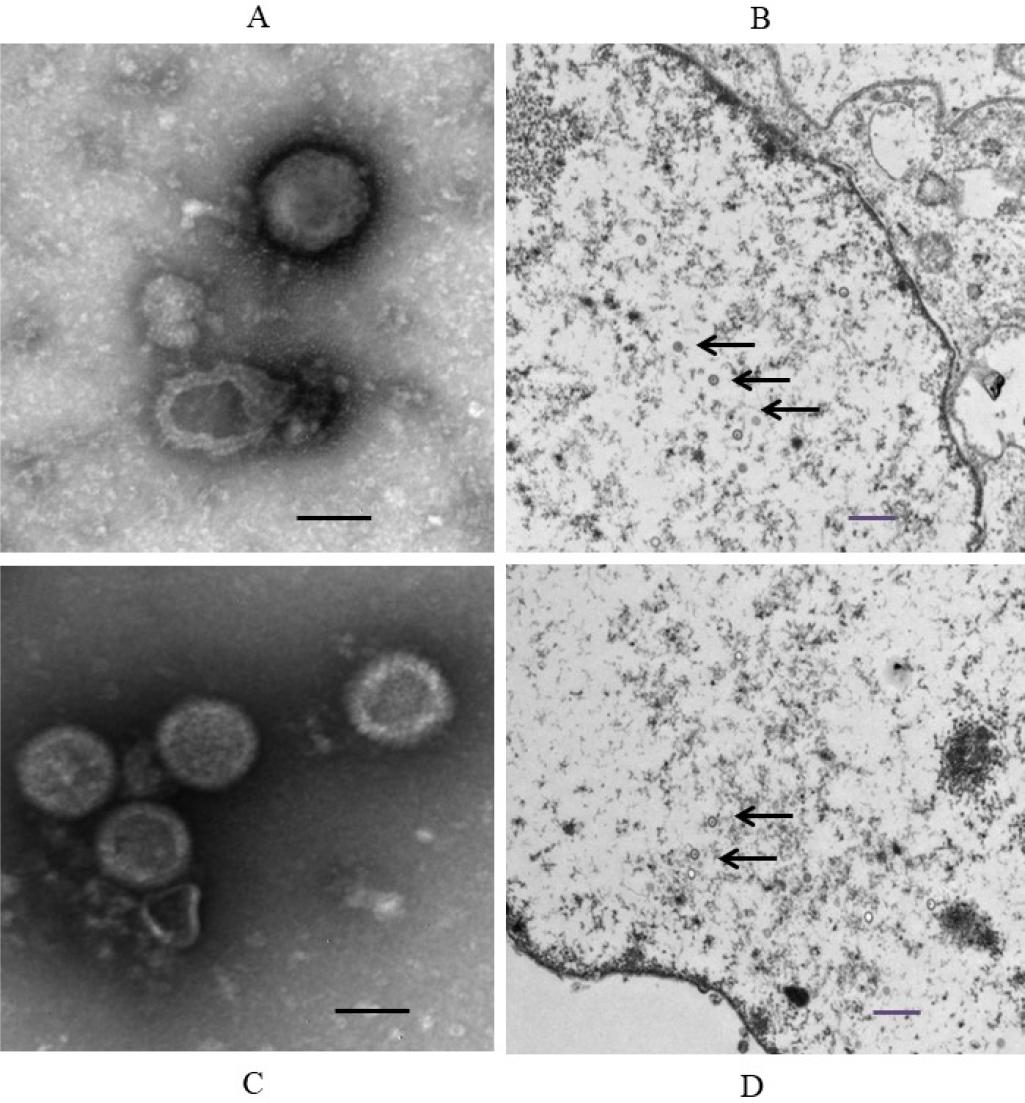Feline herpesvirus type 1 (FHV-1) can cause acute and highly contagious infectious diseases in cats, namely feline infectious rhinotracheitis. In 1958, FHV-1 was isolated and identified for the first time from kittens suffering from respiratory diseases in the United States by Crandell et al. Clinical manifestations include keratoconjunctivitis, upper respiratory tract infection and miscarriage, and upper respiratory tract infection is the main symptom. Cats of all ages can be affected, mainly affecting young cats, and the incidence rate can reach 100%. Adult cats are mostly resistant to infection, and young cats have severe symptoms after infection, and the case fatality rate can reach 50%. The most important feature of this pathogen is its wide tissue tropism. In addition to often invading the respiratory system, it can also infringe on the reproductive system, nervous system, conjunctiva and embryos.

Figure 1. Feline herpesvirus.
FHV-1 Genome Structure and Encoded Glycoproteins
FHV-1 is a double-stranded DNA virus with an envelope. The full genome sequence is 126-134 kbp, and the GC content in the base is about 50%. Its genome consists of a long unique region (UL) of 99 kbp and a short unique region (US) of 27 kbp. Its short fragment consists of inverted repeats (IRs) of 7.0-8.5 kbp long and 8-9 kbp segmented short unique sequences. US region contains genes such as gG, gD, gI, and gE, and the UL region contains gC, gH, and gB genes. The FHV-1 genome encodes a variety of proteins, 17 virus-specific proteins and 3 immunogenic glycoproteins have been reported. So far, seven glycoproteins, gB, gC, gD, gE, gG, gH and glI, have been identified, and they play an important role in virus recognition, invasion, causing infection, cell-to-cell dissemination and infection release. The four glycoproteins gC, gE, gI, and gG were not required when the virus was cultured, suggesting that these proteins are not essential for FHV-1 replication. Among them, gB is the main immunogenic protein, which is expressed in mammalian cells, causing cell fusion and polykaryon formation, and is necessary for virus replication; gD plays a major role in the firm adsorption of viruses and cells.
Structural Features of gB and gD Proteins
The gB glycoproteins are 108, 70, 64 and 58 kDa in size under denaturing conditions. Among these proteins, the 108 kDa glycoprotein FHV-1 gB has a structure similar to a heterodimer. Amino acid sequence analysis shows that it has two intracellular protease cleavage sites (RTRR/S and RSRR/S), one or two of these sites can be cleaved, and this enzymatic cleavage affects the spread of the virus between cells. The gB protein is encoded by 948 amino acids, contains 10 glycosylation sites at the nitrogen end, and contains 10 highly conserved cysteine residues in the sequence. Purified gB can induce high titers of virus neutralizing antibodies in mice, and gB-expressing vaccinia virus can also stimulate fairly high titers of virus neutralizing antibodies in rabbits. Therefore, gB can be used as a very important research object in a subunit vaccine against FHV-1 infection. The gD protein is the main component of the viral envelope. It exists on the infected cell membrane and is highly conserved and antigenic. It can specifically bind to molecules on the cell surface and induce cellular and humoral immunity in the body. It plays an important role in virus penetration into cells and is one of the main target cells of host cell immunity and humoral immune response. Nucleic acid sequence analysis showed that the FHV-1 virus genome is 1 125 bp long, encoded by 374 amino acids, and has a molecular weight of 43.2 kDa. Comparing the gD of FHV-1 with the gD gene products of other herpesviruses, it was found that the six cysteine skeletons that make up its disulfide bond are highly conserved. Anti-gD monoclonal antibodies have complement-independent virus-neutralizing properties. In other kinds of herpesviruses, although the biological functions of the gD genes are different, they are all non-essential genes for virus infection in vivo and replication in vitro.
Biological Functions of gB and gD proteins
The gB protein is a very conserved protein in the herpesviridae family and has high homology among the constituent proteins of all herpesviruses. In the herpesviridae, the gB genes of different viruses can substitute for each other, indicating that the gB genes of different herpesviruses are functionally very similar. Studies have shown that HSV-1 gB is an essential gene for virus adsorption, penetration and cell-to-cell spread, but the function of gB gene in FHV-1 replication is not very clear.
gD has hemagglutination properties and can produce hemagglutination and hemagglutination inhibition reactions. Heparin was unable to inhibit its haemagglutination properties on feline erythrocytes, suggesting that gD is insensitive to heparin. Studies have found that insect cells expressing FHV-1 gD protein can adsorb cat cell lines, but not bovine, porcine and dog cells, and this adsorption can be inhibited by the corresponding monoclonal antibody, which indicates that gD protein plays an important role in the selection of host cell . In addition, the FHV-1g D gene and the canine herpes virus gD gene can only agglutinate red blood cells of their respective hosts. It is speculated that the differences in the biological functions of the gD gene may be the reason why each member of the herpesviridae has its own unique characteristics. The gD glycoprotein is considered to be the main molecule on the surface of virions and in virus-infected cells, and monoclonal antibodies against this glycoprotein neutralize the virus after virus adsorption and show high neutralization titers, suggesting that gD may be involved in virus entry cells, and is an essential gene for virus replication, and glycoprotein D is an extremely conserved immunogenic protein. Therefore, FHV-1 gD may be one of the candidate genes for a subunit vaccine against FHV-1 infection.
